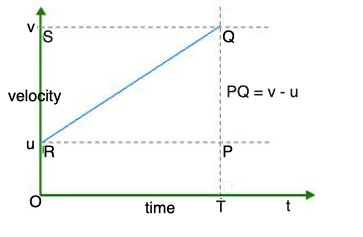Motion with uniformly accelerated motion is a motion in which the velocity of an object changes at the same rate throughout the motion.
First equation of motion:
For an object moving with constant acceleration, its average acceleration and instantaneous acceleration are equal.
$a_{avg}=\frac{v_{2}-v_{1}}{t_{2}-t_{1}}$
Let u be the velocity at time t = 0, and v be the velocity of an object at time t. Then the above equation becomes,
$a=\frac{v-u}{t-0}$
Or, $v-u=at$
Or, $v=u+at$
The above equation can be derived graphically as stated below.

Figure:3.a
Let the object reaches at point B after time (t).
From the graph,
Slope = acceleration ($a)$ = change in velocity / time
Change in velocity = PQ = $v-u$
Time = PR = t
Then, slope ($a)$ = acceleration ($a$) = $\frac{v-u}{t}$
Or, $v=u+at$ (known as the first equation of motion)
Second equation of motion:
From the above graph, the distance covered by the object at the given time t is given by the area of the trapezium ABDOE. Let in the given time ‘t’, the displacement covered by the moving object’s is given by the area of trapezium OTQSR
Displacement (s) = Area of triangle PQR + Area of rectangle OTPR
= $\frac{1}{2}\times PQ\times RP$ + $OT\times OR$
= $\frac{1}{2}\times (v-u)\times t$ + $t u$
= $(\frac{v+u}{2}) t$
Putting $v=u+at$, we get
Displacement (s) = $\frac{1}{2}(u+at$+$u$) $t$
Or, $s=ut+\frac{1}{2}at^{2}$( known as the second equation of motion)
Third equation of motion:
We have,
$v=u+at$ ……… (1)
$s=ut+\frac{1}{2}at^{2}$ …… (2)
From, equation (1), we get , $t=(v-u)/a$
Putting the value of t in equation (2), we get
$s=u(v-u)/a+\frac{1}{2}a(v-u)^{2}/a^{2}$
Or, $2as=2vu-2u^{2} +(v^{2}-2vu+u^{2})^{}$
Or, $2as=v^{2}$-$u^{2}$
Or, $v^{2}$=$u^{2}$+$2as$( known as the third equation of motion)
Free fall:
An object falling freely is influenced by Earth’s gravitational force. The acceleration produced in the falling body is called acceleration due to gravity. It is denoted by g.
The kinematic equation of motion under gravity can be obtained by replacing acceleration ‘a’ in equations of motion by acceleration due to gravity ‘g’.
$v=u+gt$
$s=ut+\frac{1}{2}gt^{2}$
$v^{2}$=$u^{2}$+$2gs$
The value of g is taken positive when the object falls vertically downwards and negative when it is projected up against gravity. The standard value of g is 9.8 $m/s^{2}.$
Problems:
1. A car accelerates from rest at the constant rate ‘a’ for some time after which it decelerates at a constant rate of ‘b’ to come to the rest. If the total time is t, then calculate the maximum velocity of the car.
Let $t_{1}$= time for acceleration
$t_{2}$= time for deceleration
$v$= maximum velocity
Then, $v=at_{1}$and $v=bt_{2}$
Or, $t_{1}$= $v/a$ and $t_{2}$= $v/b$
Total time $t=t_{1}+t_{2}$
= $v/a$+ $v/b$
= $\frac{bv+av}{ab}$
Or, $v=t\frac{ab}{a+b}$
2. A bus moving at 10 m/s is slowed uniformly to a stop in 30 s. Find the stopping distance?
$V_{i}=10 m/s$
$V_{f}=0$
$t=30 s$
We have, $V_{f}$= $V_{i}+at$
Or, $0=10+30a$
Or, $a=- 0.33$ $m/s^{2}$
The stopping distance s is given by,
$s=V_{i}t+1/2 at^{2}$
= $10\times 30+1/2 (-0.33)\times 30\times 30$
= 300 – 148.50
= 151.50 m.
